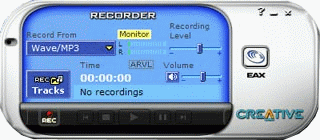Terratec DMX 6Fire 24/96 vs. Sound Blaster Audigy Platinum
Converter Quality: Subjective Tests
To complete our assessment of the two cards' recording capacity, we did a range of recording tests, which gave the following results:
Digital To Digital

The tests of recordings from a digital source to the coaxial S/PDIF input on each card were done from a Pioneer DV-343 DVD player with a digital output. The same cable was used in both tests. Overall, the cards provided much higher quality than the multimedia cards we usually test. The DMX 6Fire 24/96 has a slight lead, in that it can record directly in 96 kHz. Its fidelity is flawless and no crude loss can be heard. The 44.1-kHz tests showed the Audigy behaving pretty well, with better bass than treble and very satisfactory overall quality.
Analog To Digital
This tests the most common usage situation with this kind of card. We connected the Pioneer player to the analog input on each rack via the RCA outputs in order to see how the analog-to-digital converters worked. Here the AKM AK524 chips on the DMX 6Fire 24/96 performed better, with regard to sound fidelity and reproduction. Whether you play the master on the player or the recording on the PC, no difference can be heard. It was almost the same with the Audigy Platinum, but with a slight loss of sound dynamism and presence. Regarding the frequency range, we cannot make the same remarks as for the previous test. The DMX 6Fire 24/96 does not prioritize between bass and treble and no particular color can be heard. The Audigy Platinum reproduces the bass very well, but the treble sometimes lacks precision in playback. The Terratec card will thus please sound lovers in search of neutrality, even though it does not reach the perfection of more professional systems. The amplified mike inputs are also very different on each card. Our first Audigy tests have already shown their mediocrity. The Terratec is better, but still not adequate for professional recording.
Stay on the Cutting Edge
Join the experts who read Tom's Hardware for the inside track on enthusiast PC tech news — and have for over 25 years. We'll send breaking news and in-depth reviews of CPUs, GPUs, AI, maker hardware and more straight to your inbox.
Most Popular

